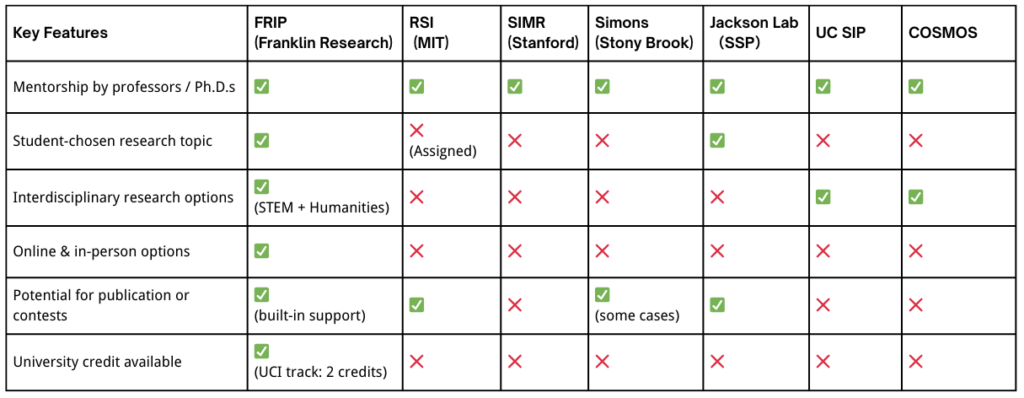Top 10 Research Programs for High Schoolers in U.S.
目录
How to Identify High-Impact Research Opportunities That Actually Matter
In today’s competitive academic landscape, participating in selective research programs for high schoolers can significantly strengthen a student’s college application—especially for those aiming at top STEM, pre-med, or Ivy League programs.
Admissions officers can easily tell the difference between a student who has merely “attended a science camp” and one who has immersed themselves in meaningful, rigorous research under expert mentorship. So how do you identify high-impact research programs that actually matter?
What Makes a Research Program Valuable?
Before jumping into the top options, here’s what differentiates a high-value research opportunity from a resume filler:
Mentorship matters: Are students working with real faculty or researchers, or just assistants?
Deliverables: Is the end product a polished paper, a presentation, a poster, or just participation?
Selectivity: Does the program require an application, recommendation letters, or academic prerequisites?
Research autonomy: Are students working on pre-designed projects or formulating their own research questions?
Recognition: Is the program affiliated with universities or institutions recognized in higher ed or STEM competitions?
If a program hits 3–4 of the above, it’s likely worth your summer.
Top 10 Research Programs for High Schoolers
(California-Based or Accessible)
Today, the number of research programs available to high school students has exploded—some resemble summer enrichment camps, while others provide rigorous science and research training with tangible academic outcomes and long-term impact.
1. Research Science Institute (RSI) – MIT / CEE
Hosted by the Massachusetts Institute of Technology (MIT) and the Center for Excellence in Education (CEE), RSI is globally regarded as one of the most elite research programs for high school students. The six-week program combines on-campus coursework with real research projects under MIT professors.
Eligibility: Grade 11 students with strong backgrounds in math and science
Location: MIT, Cambridge, MA
Focus Areas: Mathematics, physics, biology, chemistry, computer science, engineering
录取率: ~5%
🔎 Why it matters: RSI alumni often go on to study at MIT, Stanford, and Harvard, and many have published research during high school.
2. Simons Summer Research Program – Stony Brook University
For students passionate about healthcare and life sciences, participating in medical internships for high schoolers can be a transformative experience, offering early exposure to clinical research, laboratory practices, and mentorship from real-world scientists.
This highly selective program places students in faculty labs at Stony Brook University for an immersive summer research experience. Students are assigned to real university research teams and expected to contribute meaningfully.
Eligibility: Current juniors with strong science backgrounds
Location: New York (on-campus housing provided)
Focus Areas: Physics, math, biology, chemistry, engineering
Duration: 6.5 weeks
💡 Noteworthy: Students complete a final paper and present their work at a formal symposium.
3. Stanford Institutes of Medicine Summer Research Program (SIMR)
SIMR is one of the most prestigious medical internships for high schoolers, offering direct lab placements with Stanford researchers. Students spend 8 weeks working on advanced biomedical topics alongside graduate mentors.
Eligibility: California-based students (rising seniors preferred)
Location: Stanford School of Medicine, CA
Focus Areas: Cancer biology, neuroscience, bioinformatics, immunology, stem cell research
🔬 Why it’s popular: Offers hands-on medical research exposure that mimics a real pre-med or MD/PhD path.
4. Rockefeller University SSRP (Summer Science Research Program)
Located in NYC, the Rockefeller SSRP offers high school students one-on-one mentorship with world-class researchers in the life sciences. Known for its depth and intellectual rigor.
Eligibility: Grade 11 students with research potential
Focus Areas: Molecular biology, neuroscience, genetics, cellular biology
Duration: 7 weeks
🧬 Reputation: Many participants go on to submit work to national science competitions or research journals.
5. Franklin Research Internship Program (FRIP)
The Franklin Research Internship Program (FRIP) is a selective research opportunity offered in collaboration with professors from UCLA, UC Irvine, UC Riverside, and other top institutions across the country. This program is designed for high school students seeking authentic, publication-ready research experiences across a broad spectrum of STEM and humanities disciplines.
Students may participate in person—working side-by-side with university faculty in UC laboratories—or choose from an expansive set of online research offerings spanning AI, engineering, medicine, psychology, sustainability, economics, and more.
Eligibility: Motivated high school students (Grades 10–11 recommended)
Format: Online or in-person (UCLA, UCI, UCR campuses)
Focus Areas: AI, neuroscience, biomedical engineering, sustainability, quantitative genetics, psychology, economics, and more
Deliverables: Research paper, final presentation; select students may submit to journals or competitions
Mentorship: 1:1 or small-group mentorship with professors or industry experts
🎓 In-Person Tracks & Faculty Mentorship
✅ UC Irvine (UCI)
Research Areas: Mathematics, Physical Sciences, AI in Math, Engineering
Special Note: Students completing the UCI track may earn two UCI college credits.
✅ UC Riverside (UCR)
Research Areas: Genetics, Bioinformatics, Quantitative Biology, Statistical Genomics, Computational Botany
✅ 加州大学洛杉矶分校
Research Areas: Medicine, Cell Biology, Cancer Research
🌐 Online Research Tracks
In addition to the in-person UC partnerships, FRIP offers over a dozen online research focus area taught by industry-leading scientists, professors, and engineers:
Biotech & Molecular Research: Ph.D., UCSD – MERFISH, synthetic biology
Health Sciences & Biomedical Engineering: Ph.D., USC and Stanford – Public health, disease modeling
Environmental & Water Sciences: Ph.D. – Materials science, chemical engineering, sustainability
Physics & Energy: CMU and Cornell – Solar energy, rockets, mechanical systems
AI & Machine Learning: Microsoft engineers, Ph.D.s in CS, computer vision, and game design
Genomics & Statistical Biology: USDA researchers – Genetics, ML-based bioinformatics
Social Sciences & Humanities: UCI, UCD, UCSC professors – Psychology, economics, political science, history, cultural studies
Each online track emphasizes real-world application and encourages students to develop research they can submit to competitions or even publish.
6. UC Santa Cruz Science Internship Program (SIP)
SIP offers California students the opportunity to work with UC Santa Cruz researchers across multiple departments. Projects range from astronomy to oceanography to machine learning.
Eligibility: California students in Grades 10–12
Location: UC Santa Cruz campus
Focus Areas: Astronomy, data science, marine biology, ecology, machine learning
🌱 Extra edge: Great for students looking for cross-disciplinary research beyond traditional biology.
7. UC Davis Young Scholars Program (YSP)
YSP is a six-week program that places students into research laboratories on the UC Davis campus, where they conduct real experiments, attend seminars, and present findings.
Eligibility: Current Grade 10–11 students
Location: UC Davis
Focus Areas: Agricultural science, biology, environmental systems, food sciences
🌿 Why it matters: Offers publication-quality mentorship and one of the few UC-hosted research opportunities open to high schoolers.
8. The Jackson Laboratory Summer Student Program (SSP)
This program gives students access to cutting-edge research in genetics and biomedical science. The Jackson Lab is a global leader in genomic medicine and disease modeling.
Eligibility: Rising juniors and seniors with strong interest in life sciences
Locations: Bar Harbor, Maine or Farmington, Connecticut (housing provided)
Focus Areas: Genomics, gene expression, bioinformatics, biomedical research
🧪 Why join: Perfect for students interested in long-term careers in research medicine or biotech.
9. California State Summer School for Mathematics and Science (COSMOS)
COSMOS is a four-week STEM program operated by the University of California system. Students choose clusters that match their interest, like neuroscience, quantum computing, or green energy.
Eligibility: California students who have completed 8th–12th grade
Locations: UC Davis, UC Irvine, UCLA, UC San Diego, UC Santa Cruz
Focus Areas: Computer science, chemistry, climate change, cognitive science, robotics
⚡ Why it stands out: Combines college-level science with cohort-style learning and cluster mentorship.
10. The Rockefeller Neuroscience Institute High School Scholars Program (Honorable Mention)
Though not California-based, this program deserves mention due to its medical research prestige. Students work in the fields of cognitive neuroscience, neuroimaging, and behavior.
Eligibility: High-achieving juniors/seniors
Location: West Virginia University (remote options may apply)
Focus Areas: Human behavior, neuroimaging, medical decision-making
🧠 Recommended for: Students interested in behavioral medicine, psychiatry, and experimental psychology.
Research Program Comparison Table

How to Choose What Fits You Best?
With so many research programs now available to high school students, it’s important to think beyond rankings or school names. The best research experience is one that challenges you, excites you, and gives you room to grow.
Ask yourself:
✅ Does this program match your academic interest or potential major?
✅ Will you receive individualized mentorship or work in large groups?
✅ Are there clear deliverables (papers, presentations, publication)?
✅ Can you see yourself fully engaged for 6–8 weeks, or is the format too passive?
✅ Does it offer guidance through the full research cycle—from forming a question to defending a conclusion?
If your goal is to apply to selective universities or pursue careers in science, medicine, AI, or economics, you’ll want a program that shows intellectual maturity, not just participation. That often means choosing depth over prestige.
Research Isn’t About Impressing—It’s About Becoming
It’s easy to think research programs for high schoolers are just another checkmark for your college résumé—but true research does something more. It transforms how you think, how you learn, and how you solve problems.
Whether you’re working in a university lab, interviewing communities for a social science project, or analyzing genomic data from your laptop at home—what you’re really doing is learning to ask better questions. You’re learning to challenge assumptions, sit with uncertainty, and follow evidence.
That mindset—of curiosity, perseverance, and original thinking—is what makes a great researcher. And it’s exactly what top universities are looking for in students who pursue research programs for high schoolers.
Your journey doesn’t have to start with a published paper. It just has to start with one question you care enough to explore deeply.
提交表单即代表您同意接收 IvyMax 的最新资讯和课程信息。您可以随时通过邮件底部的 SafeUnsubscribe® 链接取消订阅。
对我们的项目感兴趣?
请填写表单,我们会尽快回复您,并提供详细信息,解答您的问题!

